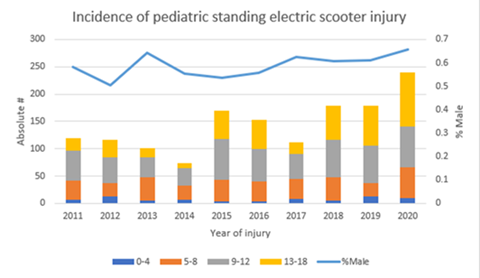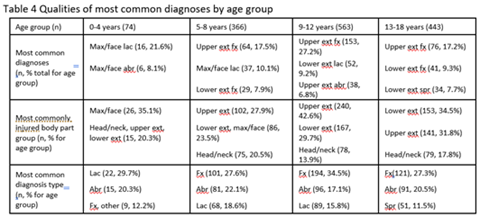During 10-Year Study, All E-Scooter Injuries Rose, Including Head Injuries and Injuries Requiring Hospitalization
ANAHEIM, CA.-- Standing electric scooters, commonly referred to as e-scooters, have been increasing in popularity across the country over the past decade. According to a new research abstract presented during the 2022 American Academy of Pediatrics National Conference & Exhibition, e-scooter injuries are becoming much more common and increasingly severe.
Authors of the abstract, “National Trends in Pediatric e-Scooter Injury,” found hundreds of e-scooter injuries between 2011-2020. The rate of hospital admittance for patients increased from fewer than 1 out of every 20 e-scooter injuries in 2011 to 1 out of every 8 requiring admittance into a hospital for care in 2020.
“The number of annual e-scooter injuries has increased from 2011 to 2020, likely due in some part to the rise in popularity of rideshare e-scooter apps,” said lead author Harrison Hayward, MD, Emergency Medicine fellow at Children’s National Hospital. “Our study has characterized the spectrum of injuries that occur in children, which helps emergency room doctors prepare for taking care of them and helps parents and families to practice better safety.”
Researchers examined a national database of pediatric e-scooter injuries that were seen in emergency departments at over 100 US hospitals from 2011-2020 to find out what kinds of injuries children were sustaining and if any trends existed. Over 10% of all patients had a head injury, including a concussion, skull fractures, and internal bleeding. The most common injuries were arm fractures (27%), followed by minor abrasions (22%) and lacerations needing stitches (17%). The average age was 11.1 years and 59% of patients were male. Admittance to a hospital rose from 4.2% in 2011 to 12.9% in 2020.
“Parents whose children are riding e-scooters need to know how best to be safe. To that end, helmets are a must, since over 10% of the reported cases were head injuries,” said Dr. Hayward. “Children should absolutely be wearing helmets while riding an e-scooter. Research has broadly demonstrated that helmets save lives for bicycle riders, and we should think similarly about e-scooters.”
The authors did not receive financial support for this research.
Dr. Harrison Hayward is scheduled to present an abstract of the study, available between 1:30-2:30 p.m. PT Saturday, Oct. 8, at Anaheim Convention Center, Hall A. To request an interview with the author, journalists may contact Ariana Perez at Ariana.Perez@childrensnational.org, 301-244-6731.
In addition, Dr. Hayward will be among highlighted abstract authors who will give brief presentations and be available for interviews during a press conference at 8:30 a.m.-10 a.m. PT Sunday, Oct. 9 in the National Conference Press Room, 213 AB. During the meeting, you may reach AAP media relations staff in the Press Room.
Please note: only the abstract is being presented at the meeting. In some cases, the researcher may have more data available to share with media, or may be preparing a longer article for submission to a journal.
# # #
The American Academy of Pediatrics is an organization of 67,000 primary care pediatricians, pediatric medical subspecialists and pediatric surgical specialists dedicated to the health, safety and well-being of infants, children, adolescents and young adults. For more information, visit www.aap.org. Reporters can access the meeting program and other relevant meeting information through the AAP meeting website at http://www.aapexperience.org/
ABSTRACT
Abstract Title: National trends in Pediatric E-scooter Injury
Dr. Harrison Hayward
Washington, DC, United States
With the rise of standing electric scooters (e-scooters) as a popular form of micro-mobility, the incidence of e-scooter-related injuries has increased. As of yet, no study has taken a granular look at patterns of e-scooter injuries seen in the pediatric population specifically. An awareness of these injury patterns is necessary in order to more accurately inform public policy and safe e-scooter practice. The purpose of this descriptive population study is to characterize the spectrum of e-scooter-related injuries in pediatric patients presenting to emergency rooms in the United States stratified by age group from 2011 through 2020 using a national database.
Encounter-level data for cases of pediatric e-scooter injuries was pulled from the National Electronic Injury Surveillance System (NEISS), a publicly available federal database published by the Consumer Product Safety Commission that collects deidentified information on consumer product-related injuries as reported by over 100 hospitals in the United States. Patients age 0 to 18 years were identified by diagnostic coding within the database and statistically analyzed. Data of interest included patient age, injury type, involved body part(s), disposition, and injury year. Broken down by age group, summary statistics with percentages were used to assess injury patterns and trends in disposition over time.
A total of 1,446 patients were identified. The average age at time of injury was 11.1 years and 858 (59.3%) were male. The most commonly injured body part group was upper extremity (495, 34.23%). 1,318 (91.1%) were discharged and 102 (7.1%) were admitted, with no fatalities reported. Of admitted patients, the most common primary diagnosis was fracture (57, 55.9%). Over the study period, the proportion of patients requiring admission increased from 4.17% in 2011 to 12.92% in 2020. The proportion of total annual patients age 13-18 years increased from 19.17% in 2011 to 41.67% in 2020.
The incidence of pediatric e-scooter injury is increasing. Using admission requirement as a surrogate for injury severity, injuries are becoming more severe. These data can help guide clinicians and inform policymakers in addressing safe e-scooter practice for the pediatric population.
Number of reported pediatric e-scooter injuries per age group by year

Total number of reported e-scooter injuries to NEISS by age group per year from 2011 to 2020
Most common primary diagnoses, involved body part groups, and injuries

Detailed breakdown of most common primary diagnoses, injured body part groups, and injuries by age group over the study period. (Max/face: maxillofacial; ext: extremity; fx: fracture; lac: laceration; abr: abrasion; spr: sprain;